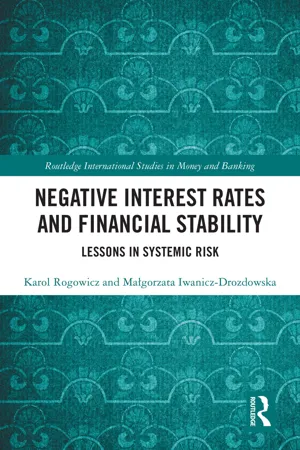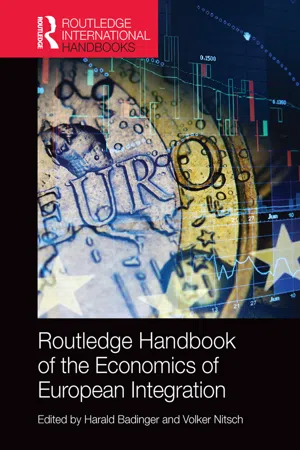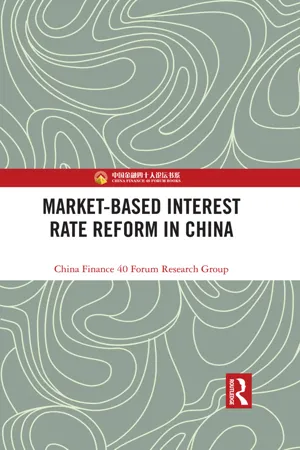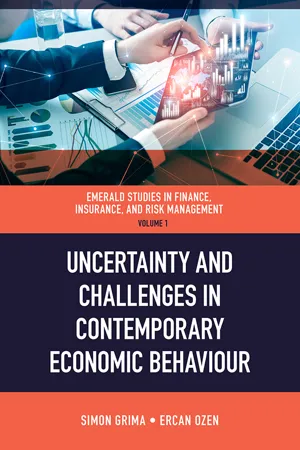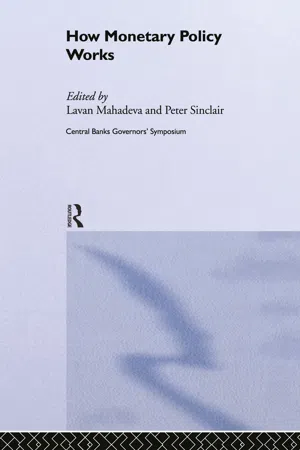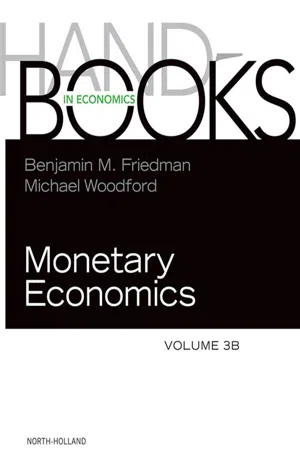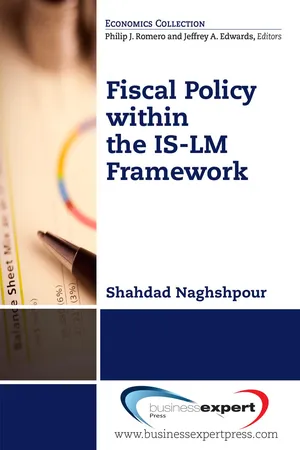Economics
Interest Rate Channel
The interest rate channel refers to the impact of changes in interest rates on the economy. When central banks adjust interest rates, it affects borrowing costs for businesses and consumers, which in turn influences spending and investment decisions. This channel is a key mechanism through which monetary policy influences economic activity and inflation.
Written by Perlego with AI-assistance
Related key terms
Related key terms
1 of 4
Related key terms
1 of 3
8 Key excerpts on "Interest Rate Channel"
- eBook - ePub
Negative Interest Rates and Financial Stability
Lessons in Systemic Risk
- Karol Rogowicz, Małgorzata Iwanicz-Drozdowska(Authors)
- 2022(Publication Date)
- Routledge(Publisher)
Brózda-Wilamek, 2018 ).Two effects can be considered as falling under the Interest Rate Channel: the interest rate directly affecting investment through the changes in cost of capital (to which Figure 2.7 referred) and the intertemporal substitution channel (the change of preferences in intertemporal choice). How the interest channel works is due to nominal price rigidity,23 which is reflected in a proportional change of real rates once the central bank changes the nominal rate (Beyer et al., 2017 ). The expectations channel, on the other hand, is a certain enhancement of the Interest Rate Channel as it shows that the central bank may affect the real economy by shaping the expectations of business entities. The expectations chiefly concern two categories: the average level of short-term interest rates in the future and the future inflation rate (e.g., Łyziak, 2011 ), whereas the effect the central banks has on them depends on the credibility of the monetary policy pursued.Figure 2.7 Simplified scheme of monetary policy mechanism in negative interest rates environmentSource: Own elaboration.The third channel regards monetary policy effect on the exchange rate. In accordance with uncovered interest rate parity, and in spite of the initial appreciation of the domestic currency after monetary policy tightening, if the domestic interest rate is higher than its foreign counterpart, depreciation will ensue in medium term so as to align the rates of return (Chmielewski et al., 2018 ). Moreover, two effects can be distinguished within the exchange rate channel (Mishkin, 2001 ): the relative price effect bearing on net exports and its opposite, balance sheet effect which bears on the balance sheet structure of business entities (scale of this influence is determined by the balance sheet net currency position; Demchuk et al., 2011 - Harald Badinger, Volker Nitsch, Harald Badinger, Volker Nitsch(Authors)
- 2015(Publication Date)
- Routledge(Publisher)
Bernanke and Gertler, 1995 ) comprises several channels of transmission, through which changes in monetary policy affect the balance sheets of financial intermediaries (banks and other lenders) and of non-financial borrowers (households and firms).Figure 9.1 Monetary policy and the credit channel Source: Reproduced fromCiccarelli, Maddaloni and Peydró (forthcoming)In particular, in the traditional bank lending channel (see Bernanke, 2007 ; Kashyap and Stein, 2000 ; Bernanke and Blinder, 1992 ; Bernanke and Gertler, 1987 ), changes in policy interest rates affect the external finance premium of lenders, ultimately constraining their ability to extend credit. Therefore, in this case changes of monetary policy affect the supply of credit. Moreover, monetary policy may also affect the risk-taking of banks through the loans (Maddaloni and Peydró, 2011 ; and Jiménez, Ongena, Peydró and Saurina, 2014 ). At the same time, though, changes in monetary rates affect the value of the assets held by households and firms that can be posted as loan collateral (housing for mortgage loans and other assets for corporate loans) and, more broadly, the net worth of non-financial borrowers. Since lending conditions depend also on the risk and the net worth of the borrowers, thus monetary rates affect the ability of borrowers to get credit. This is the mechanism of the firm and household (non-financial borrower) balance sheet channel (Bernanke and Gertler, 1989 and 1995 ).There are important problems in the identification of the credit channel, as changes to the supply and demand of credit triggered by changes in monetary rates are generally unobserved. Therefore the complete identification of the credit channel and its sub-channels remains a challenging task. The academic literature using both macro and micro data has struggled to address this fundamental identification challenge in a satisfactory manner.- eBook - ePub
- China Finance 40 Forum Research Group(Author)
- 2018(Publication Date)
- Routledge(Publisher)
From the analysis above, we can see that the factors influencing the effectiveness of central banks’ interest rate regulation include micro-level factors such as individual behavior and interest rate elasticity and macro-level factors such as financial market conditions, financing structure, central banks’ authority and credibility, and the institutional environment. Meanwhile, we should note that although interest rate elasticity and market conditions do influence policy effectiveness, central banks enjoy a special status and natural authority in using policy rates to guide market rates. Central bank communication can substantially make up for the weakness of an underdeveloped financial market. It promotes the development of the financial market and enhances the effect of the interest rate on microeconomic entities.a Basic conditions for interest rate adjustment through policy rate changes
In theory, monetary policy instruments used by central banks are determined by relevant transmission mechanisms (Zhou, 2004). The differences in the choice of the adjustment approach results from the different understanding of the transmission mechanism of monetary policies. Chinese experts traditionally hold that the credit channel should take up a critical position in monetary policy transmission as the interest rate formation mechanism needs improvement, the financial market is still not mature, microeconomic players are not sensitive enough to interest rate changes, indirect financing takes up a leading role, and substantial financial control still exists. This line of reasoning is only a revision of the traditional adjustment mechanism through the Interest Rate Channel. Credit channel is not a distinct, freestanding alternative to the traditional transmission mechanism; it just enhances and amplifies the Interest Rate Channel (Bernanke and Gertler, 1995). In this sense, it is hard to totally separate the effect of interest channel, credit channel, and money supply adjustment; it is also inappropriate to conclude that China’s monetary policy transmission mainly relies on quantitative measures simply because China has yet to establish multi-tier market rates and transmission mechanisms or microeconomic players are not sufficiently interest rate sensitive. Moreover, judging from the market environment and PBOC’s influence on interest rates, China has already established a market-based interest rate system and transmission mechanism that is sensitive and effective (Zhou, 2013b). - Ercan Özen, Simon Grima(Authors)
- 2020(Publication Date)
- Emerald Publishing Limited(Publisher)
In the economics literature, there are studies dealing with from various perspectives the functioning of the monetary transmission mechanism in countries. In some studies, the channels of monetary transmission mechanism have been considered separately, and in some studies, some channels have been considered jointly. In terms of Turkey’s economy, studies of the functioning of monetary transmission mechanism have been also made.Taylor (1995) reported that interest channel is the most noteworthy channel in any monetary transmission. Chirinko and Von Kalckreuth (2003) presented that interest channel and credit channel are significant attributes for fixed investment in Germany. In their research, they evidenced that (inflation expectation not destructing the change) 100 points of fall in nominal interest rates could lead to 7.55% slump in investment expenditures and approximately 1.40% jump in gross domestic product (GDP) in two years.By using vector autoregression (VAR) and error correction models Guerra, Rodriguez, and Sänchez (1998) examined monetary transmission mechanism for the period of 1985–1995 in Venezuela.Butzen, Fuss, and Vermeulen (2001)- eBook - ePub
- Lavan Mahadeva, Peter J N Sinclair(Authors)
- 2004(Publication Date)
- Routledge(Publisher)
In conclusion, a tightening of monetary policy should cut asset values and, at least temporarily, reduce investment. These effects should be stronger, and more easily discerned, in real-estate prices and construction activity than in equity prices and non-construction investment. Yet monetary factors form only one of several influences affecting all these variables. Furthermore, since interest rates are normally changed for a reason—to try to offset the inflation effects of some shock—it is hard in practice to disentangle the consequences of interest rate changes from those of the shock that precipitated them. This applies to investment no less than to consumption.2.7 ConclusionThis chapter has examined how and why policy interest rates changed, and then turned to key initial aspects of the transmission mechanism for policy rates—their impact on other interest rates, other asset prices, and the major components of aggregate demand, consumption and investment. The next stages of the transmission mechanism concern how a change in the level of aggregate demand translates into changes in output and prices, and labour markets. These questions, together with the special features of the open economy, statistical features of inflation, and evidence on interest rates and disinflation, are examined in Chapter 3 .AppendixThis Appendix begins with the short run econometric results tracing the links from central banks’ policy rates to retail deposit rates (Table 2.3 ) and retail lending rates (Table 2.4 ). This is followed by regression statistics for changes in real consumption growth against changes in nominal rates, levels of real rates, and other regressors (Table 2.5 ).Notes Regression of the change in deposit rates on a constant, ECM-1, change in the central bank rate (non-lagged and one lag), the change in deposit rates (one lag and two lags).Table 2.3Dynamic regressions of short-run adjustment from central bank rates through to deposit rates.Monthly data. Sample period is 1980. 1 to 2000. 12 unless adjusted to match that of quarterly estimate; long run equilibrium correction mechanism (ECM) series constructed using co-efficient from quarterly data estimate. ***, **, *: significance of estimate at 1%, 5%, and 10% respectively; t-statistics in brackets; data source: International Financial Statistics. - eBook - ePub
- Benjamin M. Friedman, Michael Woodford(Authors)
- 2010(Publication Date)
- North Holland(Publisher)
The contrast arises from the fact that, both at the decision level and for purposes of policy implementation, what most central banks do is set short-term interest rates. In most cases they do so not out of any inherent preference for one interest rate level versus another, but as a means to influence dimensions of macroeconomic activity like prices and inflation, output and employment, or sometimes designated monetary aggregates. But inflation and output are not variables over which the central bank has direct control, nor is the quantity of deposit money, at least in situations considered here. Instead, a central bank normally exerts whatever influence it has over any or all of these macroeconomic magnitudes via its setting of a short-term interest rate.At a practical level, the fact that setting interest rates is the central bank’s way of implementing monetary policy is clear enough, especially now that most central banks leave abandoned or at least downgraded the money growth targets that they used to set. (This happened mostly during the 1980s and early 1990s, although some exceptions still remain.) The centerpiece of how economists and policymakers think and talk about monetary policy is now the relationship directly between the interest rate that the central bank fixes and the economic objectives, such as for inflation and output, that policymakers are seeking to achieve. (Further, even when central banks had money growth targets, what they mostly did in an attempt to achieve them was set a short-term interest rate anyway.)This key role of the central bank’s policy interest rate is likewise reflected in what economists write and teach about monetary policy. In place of the once ubiquitous Hicks-Keynes “IS-LM” model, based on the joint satisfaction of an aggregate equilibrium condition for the goods market (the “IS curve”) and a parallel equilibrium condition for the money market for either given money supply or a given supply of bank reserves supposedly fixed by the central bank (the “LM curve”), today the standard basic workhorse model used for macroeconomic and monetary policy analysis is the Clarida-Galí-Gertier “new Keynesian” model consisting of an IS curve, relating output to the interest rate as before but now including expectations of future output too, together with a Phillips-Calvo price-setting relation. The LM curve is gone, and the presumption is that the central bank simply sets the interest rate in the IS curve. The same change in thinking is also reflected in more fundamental and highly elaborated explorations of the subject. In contrast to Patinkin’s classic treatise (1956 , with an important revision in 1965) , Money, Interest, and Prices , Woodford’s 2003 treatise is simply Interest and Prices - eBook - ePub
- Shahdad Naghshpour(Author)
- 2014(Publication Date)
- Business Expert Press(Publisher)
By the term efficiency we refer to the speed of achieving the desired full employment level of output. This discussion also ignores the ongoing dispute regarding the ability to implement one policy or the other, the accuracy in timing expansionary policy, or difficulty in esti mating the appropriate amount of expansion required to achieve the desired objective. Some of these issues were discussed in Chapter 2 under the topic of inside and outside lags. An important distinction between the classical and Keynesian economists is how the interest rate is determined. According to classical economic theory the interest rate is determined through decisions to save and invest. In fact, investment for these economists is a kind of consumption. An increase in investment goods results in an increase in the production of consumer goods in the future. Therefore, investment is a mechanism that shifts consumption from the present time to future via the influence of the interest rate. Keynesians, on the other hand, argue that the interest rate is determined in the money market. However, for them, the link between investment and the interest rate is through the MEC, which is based on the present value of the expected future stream of earnings from investment. Chapter 5 Liquidity Preference The notion of liquidity preference provides another way of conceptualizing the demand for money. However, the term money is a broader concept than liquidity. Money is a temporary abode of value, 1 and it can also be defined as anything that is acceptable in exchange for a good or service. For more detail on definitions of money and its different types refer to Naghshpour. 2 The distinction among the types of money is based on the ease of converting it to cash, or its liquidity - eBook - ePub
- Jagdish Handa(Author)
- 2002(Publication Date)
- Routledge(Publisher)
part sevenTHE RATES OF INTEREST IN THE ECONOMYPassage contains an image
chaptertwentyTHE MACROECONOMIC THEORY OF THE RATE OF INTERESTThe rate of interest is one of the endogenous variables in the Keynesian and classical models, so that its analysis is properly conducted as part of a complete version of those models. These were presented in Chapters 13 and 14.This chapter singles out the competing views on the determination of the rate of interest and focuses on their differences and validity. It also highlights the very important difference between the comparative static and the dynamic determination of the rate of interest.key concepts introduced in this chapter
• The Fisher equation of the nominal rate of interest• Stocks versus flows of funds• The loanable funds theory• The liquidity preference theory• The excess demand function for bonds• The dynamics of interest rate determination• The neutrality of money and inflation for the real rate of interestMacroeconomics avoids the bewildering array of interest rates on the numerous assets in the market by focusing on one single rate of interest, without completely specifying which rate of interest it is, as for example in the IS-LM model of Chapters 13 and 14
Index pages curate the most relevant extracts from our library of academic textbooks. They’ve been created using an in-house natural language model (NLM), each adding context and meaning to key research topics.
Explore more topic indexes
Explore more topic indexes
1 of 6
Explore more topic indexes
1 of 4
